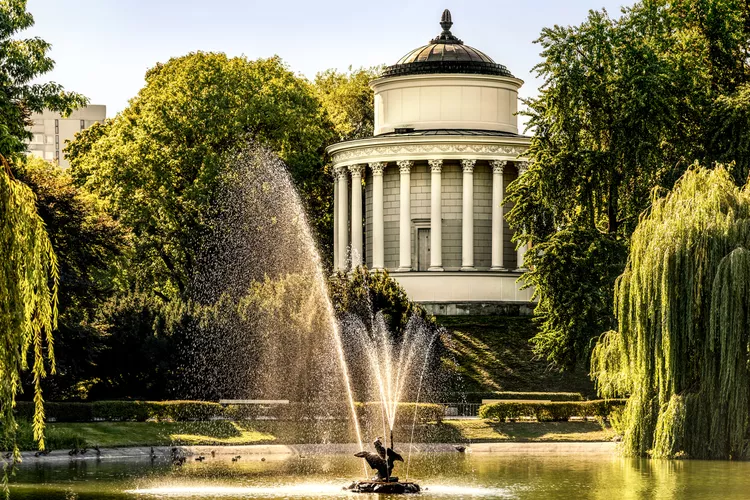Travel to Poland during the summer months of June, July, and August, and you will be welcomed with festivals, outdoor concerts, and warm weather.
Poland’s climate can be divided into three distinct parts—the coast, inland areas, and the mountains—each of which presents unique weather patterns throughout the season. In summer, the coastal cities like Gdynia, Szczecin, and Gdansk, as well as the inland hub of Warsaw, experience warm, mild days with chilly nights. Conversely, cities in the mountainous regions such as Zakopane tend to have colder temperatures year-round.
During this season, opportunities for outdoor fun and leisure abound. You can bask in the sunshine on historic squares while enjoying a refreshing Polish beer or your favorite flavor of lody (translated as “ice cream” in Polish). Additionally, consider taking tours to the countryside to uncover the diverse offerings of Poland.
Poland Weather in the Summer
Summer is the warmest season across Poland. Consequently, even the mountain villages can see temperatures reach the upper 50s and 60s, while lowland areas may experience highs around 80 degrees Fahrenheit (27 degrees Celsius). Overall, the country enjoys an average daytime temperature of 63 degrees Fahrenheit (17 degrees Celsius) alongside a nighttime low of around 48 degrees Fahrenheit (9 degrees Celsius).
| City | June | July | August |
|---|---|---|---|
| Gdansk | 66 F (19 C) / 52 F (11 C) | 70 F (21 C) / 55 F (13 C) | 70 F (21 C) / 55 F (13 C) |
| Sniezka | 50 F (10 C) / 39 F (4 C) | 54 F (12 C) / 45 F (7 C) | 54 F (12 C) / 45 F (7 C) |
| Warsaw | 72 F (22 C) / 52 F (11 C) | 75 F (24 C) / 55 F (13 C) | 73 F (23 C) / 54 F (12 C) |
Unfortunately, summer is also the rainiest season across much of the country. Therefore, cities in Poland may see rainfall on up to 10 days per month. While the country does not accumulate excessive rainfall annually, it does receive between two to three inches each month during the summer, regardless of your location.
What to Pack
Regardless of whether you are traveling to the mountains or the coast, it is essential to bring various clothing options, enabling you to layer for the fluctuating temperatures from day to night. While shorts and a t-shirt may suffice during the day along the coast, opting for pants and a long-sleeved shirt is advisable if you are heading to the southern mountains. Additionally, pack an umbrella and waterproof shoes, as thunderstorms are a common occurrence across much of Poland.
Summer Events in Poland
Planning your summer travel to Poland requires some advance preparation, especially if your visit coincides with a major festival like Wianki. These annual events attract both locals and tourists, leading to crowded streets and often fully booked hotels and restaurants. Consequently, it is beneficial to check the events calendar for festival dates before you travel.
- Juwenalia: This lively summer music festival typically takes place in late May or early June, providing students a fantastic opportunity to unwind after a year of study.
- Wianki: This midsummer Polish tradition unfolds along riverbanks like the Vistula in Krakow, where colorful wreaths are floated downstream, continuing a summer solstice practice rooted in Pagan history.
- International Festival of Jewish Culture: Held in Krakow, this celebration draws thousands of visitors to Poland’s cultural capital in early summer, showcasing various performances, parades, and religious services at local synagogues.
- Folk Art Fair: Scheduled for June or July, this festival in Krakow honors the city’s vibrant folk art culture.
- Krakow Summer Jazz Festival: One of Europe’s grandest jazz celebrations, this annual event typically occurs in July or August.
- Summer Festival of New Town: Parks and gardens in Warsaw host outdoor concerts throughout the summer, featuring genres and performances from around the globe.
Summer Travel Tips
- June, July, and August are peak travel months for Poland; thus, tourist centers are often bustling with visitors from all parts of the globe.
- Crowded tourist areas can attract pickpockets; therefore, remain vigilant and keep your belongings secure.
- Many cities situated near waterways—including Warsaw, Sandomierz, and Stalowa Wola—offer picturesque river cruises, providing an enjoyable way to appreciate the scenery. Additionally, seek out outdoor musical performances in parks, such as those dedicated to Chopin in Warsaw’s Lazienki Park.
- If exploring the western areas of Poland, embark on a hunting adventure for dwarfs in Wroclaw; moreover, coastal cities like Gdansk offer chances to sunbathe or search for amber on the beach.
- After experiencing the major urban areas, consider venturing into the countryside to visit attractions particularly appealing in warmer weather when tours are abundant.
- From Krakow, you can explore the cool underground chambers of the Wieliczka Salt Mine or visit the revered Black Madonna of Czestochowa. Additionally, from Gdansk, a short train ride will take you to Malbork Castle or to various notable Polish castles and World Heritage sites.
- Summer is an excellent time to discover different regions of Poland; for instance, Silesia is known for its stunning natural landscapes and significant sites like the Peace Churches of Swidnica and Jawor, while Malopolska is rich in history and castles.





